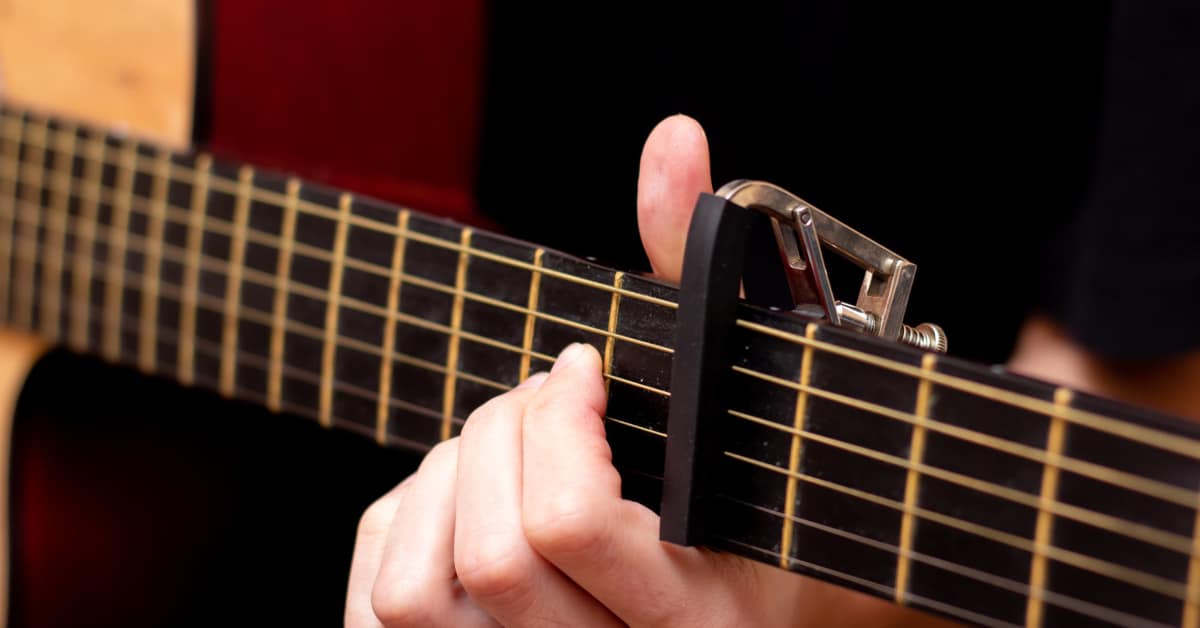Yes, there are various types of capos for guitars, and they vary depending on their purpose. The type of capo you should use is determined by your music style, convenience, and the tune you wish to play.
Different Types Of Guitar Capos
G7th Capo
G7th capos utilize an advanced pressure-based system that adjusts the tension when you’re squeezing their handles together. It is highly convenient to move throughout the fretboard and is equipped with a rubber pad inside.
Pros:
- Simple design
- Easy and simple to adjust
- Applicable for both acoustic and electric guitars
- Unique tension
- Equipped with rubber contact
- Fast release
Cons:
- Expensive
Trigger Capo
Trigger capos work similarly to the “chip clip” on your bag of chips. They are also very easy to use. Simply press the clamp and place it over the guitar neck to clamp down the strings. This easy-to-use feature makes them very popular among guitarists.
Pros:
- Easy and convenient to use
- Effortless to move around, which is perfect for live performances and situations
- Solid attachment
- Durable
- Affordable
Cons:
- No tension adjustment
- It May cause problems with Fret Board
- Can cause your guitar to go out of tune
Spring Capo
Spring Capos are similar to trigger capos. However, they utilize a much more advanced mechanism in applying pressure.
Pros:
- Effortless to move
- Movable with one hand
- Direct springs are more solid than chip-clip-styled springs of trigger capos.
Cons:
- May cause intonation problems since tension are coming from one side of the capo
Screw Capo
Screw capos are adjustable and have been around for a very long time. Every old acoustic guitar case you open may seem to have a Shubb hanging out in the pocket. This capo works by tightening a screw on the back of the guitar neck and putting pressure on it (typically through an arm) to enable the screw to equally apply pressure from the back. This is a good and preferable capo for recording or practicing at home.
Pros:
- Equally applied pressure by the screw
- Inexpensive
- Keep the guitar in tune for long periods
Cons:
- Inconvenient to move and position quickly
- Requires both hands to position
- Takes time to fit in the guitar
Shubb Capo
Shubb Capos utilize an adjustable lever system, allowing it to be easily flipped on or off.
Pros:
- Unique tension applied on the guitar’s fret
- Equipped with rubber contact which mimics real fingers.
- Effortless to remove
Cons:
- Expensive than most capos
Partial Capo
Partial capos use a Shubb-like design but only and purposely cover only 3 strings of your guitar.
Pros:
- Enhances user’s creativity
- Unique to the audience when performing
Cons:
- Expensive
Spider Capo
Spider Capos are different from other capos that typically utilize a full bar across strings. It functions by controlling your guitar strings on an individual level.
Pros:
- Fully Modifiable
- Simple to use
- Fine-tuning
- Fast Release
- Works perfectly on both electric and acoustic guitars
Cons:
- Expensive
Roller Capo
Roller capos are easy to move around the fretboard primarily because of their position on a rolling system.
Pros:
- Easy and quick to reposition
- Can easily access open strings
- Equal fret pressure
Cons:
- Tension is unadjustable
- Can easily scratch guitar due to many metal surfaces and materials
- Limited neck size which may not be applicable for 12-string classical guitars
Cradle/Yoke-style Capo
Adjustable screw capos are comparable to yoke-style/cradle capos. They both apply pressure to the capo with a screw on the back of the guitar neck. However, the yoke-style/cradle capo completely wraps around the neck. This permits the screw to apply pressure to the back of the neck from the dead center. A hinge allows the front capo pad to swing open.
Pros:
- Unique design
- Equal pressure/tension applied by the center screw at the back
- Convenient (can be stored on guitar nut when not in use)
- Quick-release
- Applicable for both electric and acoustic guitars
Cons:
- Requires more effort and both hands to move around to put on and off
Strap Capo
Strap capos are what they sound like: they attach to the guitar neck with a strap. The capo consists of a bar with an elastic or adjustable strap connected with one another.
Pros:
- Simple to use
- Affordable
- Effortless to slide through the neck
Cons:
- Elastic straps easily wear out
- Although rare, it has a tendency to slip slightly in a position which affects intonation
- Requires both hands to adjust
Toggle Capo
Toggle capos are similar to strap capos. However, the method of tightening this capo’s strap is by pulling a toggle that snaps the capo tight, comparable to a latch found on toolboxes.
Pros:
- Affordable
Cons:
- The toggle strap mechanism may cause the strings to go out of tune
- Requires both hands to adjust
- Quickly wears out
- Can sometimes cause slippage
- Often used incorrectly by users in terms of tightness


